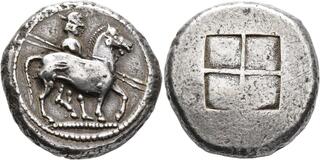| Leu Numismatik AG > Auction 15 | Auction date: 1 June 2024 |
| Lot number: 50 Price realized: This lot is for sale in an upcoming auction - Bid on this lot  | Show similar lots on CoinArchives Find similar lots in upcoming auctions on |
| Lot description: KINGS OF MACEDON. Alexander I (?), 498-454 BC. Tristater or Oktadrachm (Silver, 30 mm, 29.47 g), circa 480s-470s BC. Horseman, wearing chlamys and petasos, holding two javelins and walking slowly to right behind bridled horse standing right, left foreleg raised; on the flank of the horse, symbol or monogram (?). Rev. Quadripartite incuse square. AMNG III, p. 49, 6 ('Bisaltai'). S. Brackmann: Alexandros I. oder Bisaltai, in: JNG 65 (2015), pp. 1-8. HGC 3.1, 753. Peykov A3020 ('Bisaltai'). Raymond pl. II, 5. SNG ANS 1. SNG Lockett 1266 ('Bisaltai'). Svoronos, HPM, pl. XII, 6 ('Bisaltai'). Tzamalis, Ethné, Groupe B.2., 129 and pl. 28, 129 (this coin, D51/R52). Very rare. A beautifully toned and unusually well struck example with a fine pedigree. Minor doubling on the obverse and with light scratches on the reverse, otherwise, very fine. Ex Classical Numismatic Auctions 1, 1 May 1987, 30, Sternberg XIV, 24-25 May 1984, 65, Leu 28, 5 May 1981, 72 and Münzen & Medaillen AG XIX, 5 June 1959, 384 ('Magnifique example d'art archaïque, rustique et spontané. D'une grande rareté.'). Given that both the Bisaltai and Alexander I issued this type with the addition of an ethnikon or royal name, the attribution of anonymous pieces like ours remains contentious. Brackmann highlighted reverse die links to pieces bearing the name of the Bisaltai tribe, yet this merely suggests that the coins were produced in the same mint, not that they were issued by and for the Bisaltai, as he himself admits. Many scholars perceive the lack of inscription as suggesting an early production date for the coins. However, it is possible that these coins represent alliance coinages between the Macedonian King and the tribal community, with deliberate omission of names for political expediency. We have adopted the more common attribution to Alexander I here, albeit with a lingering question mark since consensus regarding their origin has yet to be reached. What remains undeniable, however, is that these impressive large silver coins - whether tristaters or oktadrachms - fit well within the broader context of minting large silver denominations in the Thracian-Macedonian region, as previously discussed in the commentary on lot number 40 above. Estimate: 7500 CHF |  |



